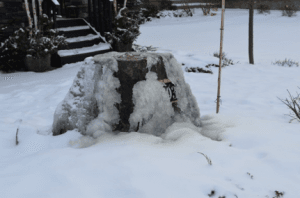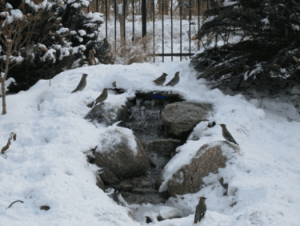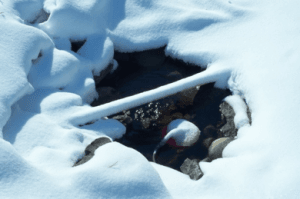Preparing for the winter always starts with the soil. Once all of the leaves have been cutback then you can see the soil. If you have larger spaces in the perennial garden, an annual garden, or vegetable garden it is a good idea to take a shovel or spade
and dig down at least six inches and turn over the soil. You don’t have to break up the lumps as the idea is to expose any eggs that have been laid to the winter’s killing cold. Also, this opens up the soil and allows more oxygen to penetrate deep into the earth. I do know many people that also add their amendments at this time. You can usually buy them on sale, but also it saves time from having to purchase and spread in the middle of a very busy spring. Here again just be mindful of leaf diseases. Ensure that everything has been removed first so that you are not burying fungal diseases under your amendments.
Once that is complete, then you will need to turn your attention to ponds, waterfalls, and water features.  Running water from a waterfall will continue to operate until about minus seven Celsius. Although, one year I went to bed and woke up to minus fourteen and the waterfall was still fine. However, I wouldn’t recommend that. Pumps need to be pulled out and put in the house or garage for the winter. Just as with your irrigation system any water that freezes in the pump can potentially damage it. Water features, for example, bird baths or tiered fountains should be covered with a tarp. It can crack if ice forms, but also the dyes used in the concrete, or especially, in plastic can fade over time. Of course, you will drain your feature as well.
Running water from a waterfall will continue to operate until about minus seven Celsius. Although, one year I went to bed and woke up to minus fourteen and the waterfall was still fine. However, I wouldn’t recommend that. Pumps need to be pulled out and put in the house or garage for the winter. Just as with your irrigation system any water that freezes in the pump can potentially damage it. Water features, for example, bird baths or tiered fountains should be covered with a tarp. It can crack if ice forms, but also the dyes used in the concrete, or especially, in plastic can fade over time. Of course, you will drain your feature as well.
Now with ponds and fish, you can keep them outside if your pond is a proper depth,
at least two feet (60cm). You will stop feeding your fish in mid-October as the fish are not able to digest properly in cold water. You will need another pump that isn’t too strong but enough to create a small burble in the water. This will keep the water oxygenated through the winter. And then you will need a pond heater. They are usually sold at greenhouses that sell pond supplies. I had fairly hardy goldfish and kept my fish outside for many years, the larger ones always made it but some of the smaller ones were hit and miss. I kept my heater on a timer so that ice formed on the surface of the pond except for around the burbler, and then used a rubber pond liner for extra insulation whenever it got down into the depths of the minus twenties and thirties. Because you do have moving water, you will have evaporation and therefore you will need to top up the pond periodically. My pond was small so I had to top up every couple of weeks.
This expert comes from Kevin Napora’s book The Perfect Time to Garden.

Kevin Napora, Landscape Designer & Master Gardener, Salisbury Landscaping, Edmonton & Area



